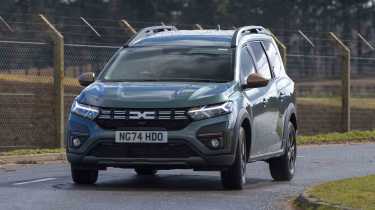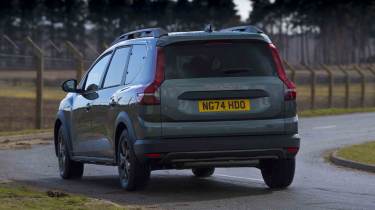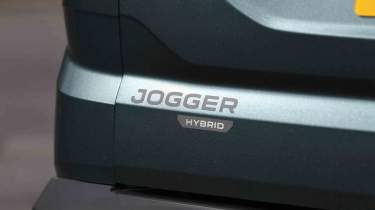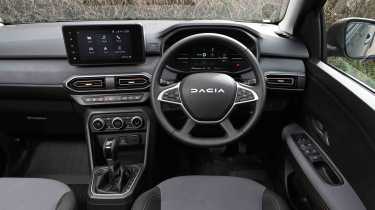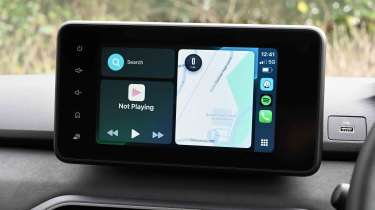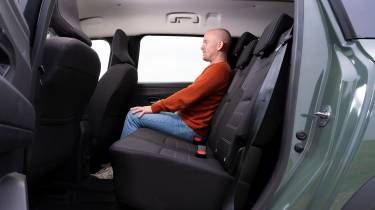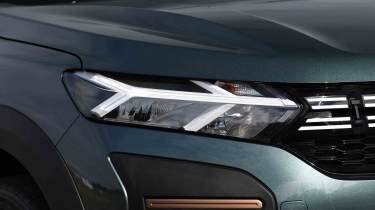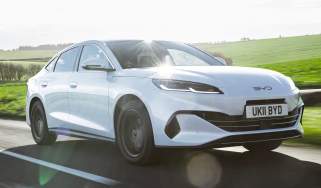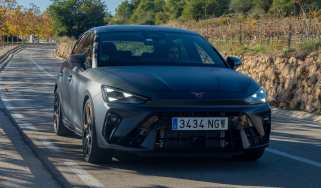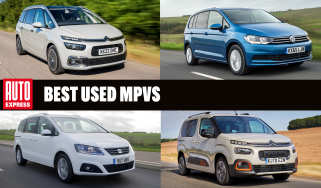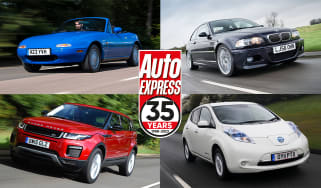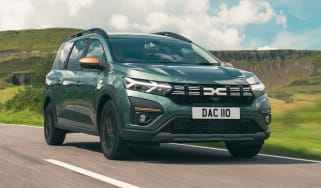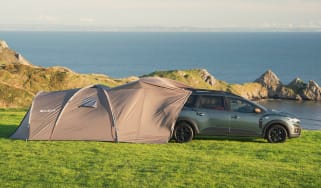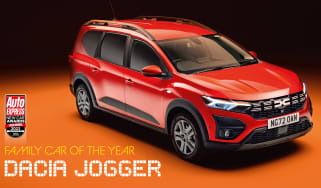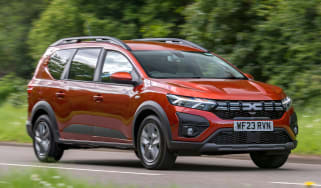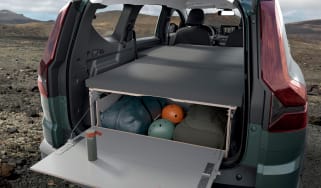Dacia Jogger review
Need a seven-seat car on a budget? The Dacia Jogger is the perfect option

Our opinion on the Dacia Jogger
Finding a direct rival for the Dacia Jogger was incredibly difficult at the time of its launch. Yes, there were plenty of seven-seaters around, and there were lots of estate cars and SUVs, too, but none managed to merge those three qualities together in one car, nor offer anything similar for anywhere near the price. Even van-based people movers were much more expensive.
Now, the Jogger has much closer rivals in the forms of the Citroen C3 Aircross and Vauxhall Frontera – two models that share a lot of tech – but the Dacia holds an advantage in a few key areas. Huge space, low running costs (thanks to frugal powertrains and strong resistance to depreciation) and keen pricing make it a compelling, if unusual, option.
About the Dacia Jogger
If you want the cheapest seven-seat new car for sale today, then the Dacia Jogger is it. However, more than just being a passenger carrier, the Jogger is a practical estate car that offers versatility and low running costs, and it just happens to have two additional seats in the boot.
Essentially, it’s a stretched Dacia Sandero supermini with an estate-car body and some SUV-style design touches. But overall it’s a no-nonsense car that follows a template that hasn’t done Dacia’s other models any harm. The Jogger hides its budget roots very well – it’s only really noticeable in the quality of some of the materials used in less obvious places in the cabin – while the frugal petrol and hybrid engine options offer enough performance for family duties.
Used - available now

2024 Dacia
Jogger
21,747 milesManualPetrol1.0L
Cash £14,027
2024 Dacia
Jogger
22,975 milesManualPetrol1.0L
Cash £13,811
2024 Dacia
Jogger
25,851 milesManualPetrol1.0L
Cash £15,495
2024 Dacia
Jogger
26,983 milesAutomaticPetrol1.6L
Cash £18,549Every model has front-wheel drive, and there are just two engine options offered, a 1.0-litre three-cylinder petrol mild hybrid, or a 1.6 four-cylinder full hybrid, with the latter coming exclusively with an automatic gearbox.
Unlike van-based seven-seaters that have sliding side doors, the Jogger retains conventional side doors, while there’s an estate-style top-hinged tailgate at the rear. Inside is a seven-seat cabin, with a pair of removable chairs in the boot, so you can choose between taking passengers and maximum cargo capacity.
Dacia Jogger prices and latest deals
How much does the Dacia Jogger cost? Well, official ‘on the road’ prices range from £18,700 to £24,100 but you can currently save an average of £619 through the Auto Express Find A Car service, where prices start at £18,440. You can lease a Dacia Jogger from £270 per month or buy a used model at prices starting from £10,899.
Check out our latest new car deals, leasing deals and used car deals for the top offers available now on Auto Express. And don't forget we can help you sell your car, too.
Prices start from around £19,000 for the Jogger, but even the top-spec Extreme version with hybrid drive still comes in at less than £25,000. What’s more, you can save an average of around £600 on that by going through the Auto Express Buy a Car service, where the latest new car deals, leasing deals and used car deals are available. And don't forget we can help you sell your car, too.
Performance & driving experience
Pros |
|
Cons |
|
The Jogger is relaxing, comfortable and composed enough for family life. High-speed refinement could be better, but otherwise it gets the job done without much fuss.
The Dacia Jogger engine range is fairly straightforward, with a choice of two engines: a 1.0-litre, TCe three-cylinder turbocharged petrol manual or a four-cylinder 1.6-litre petrol hybrid with an automatic gearbox. The 1.0-litre is an adequate option in a car with space for seven, but not exactly powerful, so those who want a little more performance can turn to the Hybrid model.
This set-up comes from Dacia’s parent brand Renault, and combines a 1.6-litre petrol engine with twin electric motors. The main 49bhp motor can power the Jogger on electricity alone for short distances through a 1.2kWh battery. The other is what Dacia calls a “high-voltage starter/generator”, which fires up the petrol engine when it’s needed, and also controls the shifts in the ‘dog box’ transmission – used because Dacia says it’s more efficient than either a traditional torque converter or dual-clutch automatic.
The electric motor moves the Jogger off the mark smoothly and silently. When more power is needed, or the battery runs low, the four-cylinder petrol engine wakes up; it’s smoother than the three-cylinder unit in the Citroen C3 Aircross, but there’s a high-frequency buzz that can be felt through the pedal.
In everyday use, the electric motor fills in the power band as the engine gets up to speed, and it means the powertrain delivers decent responses. There isn’t the kind of high revving that you get from other hybrids such as the Toyota Yaris, because the powertrain seems to favour electric drive over the petrol part of the system.
It’s an effective set-up when accelerating, but it’s a little trickier to keep a constant speed. The system seems to want to switch between electric and petrol modes all the time, so you’re constantly adjusting your foot on the throttle to maintain momentum, which can be a little frustrating.
| Model | Power | 0-62mph | Top speed |
| Jogger 1.0 TCe | 108bhp | 11.2 seconds | 108mph |
| Jogger 1.6 Hybrid | 138bhp | 10.0 seconds | 104mph |
Performance, 0-60mph acceleration and top speed
A 0-62mph time of 10 seconds for the Hybrid is a little behind its rival from Citroen, but that electric motor makes it feel more responsive for the most part – it’s only when accelerating hard up to the national speed limit that the difference becomes more obvious.
As the hybrid system tries to switch between power sources, it can occasionally feel laggy. Try to encourage a little urgency as you reach motorway speeds and the system wants to shift up right at the 70mph mark, but it creates a pause in the power for a couple of seconds – long enough to feel like you’re actively losing speed. Still, when driven gently, the tech tends to be a little smoother.
Town driving, visibility and parking
The Jogger isn’t particularly large by seven-seater standards – at 4,547mm long, it’s 244mm shorter than a Peugeot 5008, for example – but its wheelbase is large for its size, falling only about 100mm short of an Audi A8’s. That doesn’t help with low-speed manoeuvrability, though, and the Jogger’s turning circle isn’t great. Fortunately, rear parking sensors are standard across the range.
The Hybrid version only has a small battery, so it won’t run on electric drive for very long when accelerating, but there is a B mode that allows for energy recovery when coming to a halt. This is useful because the brake pedal itself is a little inconsistent with its feel, so it’s better to use B mode and coast as much as possible.
All versions of the Jogger come with 16-inch wheels – alloys only for Extreme trim – so the ride is comfortable at urban speeds.
Country road driving and handling
The Jogger’s ride isn’t set up to be sporty in any way, with comfort a priority. However, its ride is firmer than the C3 Aircross’s – not to the point of being harsh by any stretch, but enough to make it feel a little better controlled over bumpier roads.
The Dacia’s handling is more responsive on twisting roads, too. In fact, once up and running, the Jogger doesn’t feel any more unwieldy to drive than the Sandero supermini. It’s more responsive than other seven seaters, such as the latest Citroen C3 Aircross and any of the van-based people carriers on the market. The steering is fairly light, but gains a little weight through corners, which gives the driver a little more insight into how it’s behaving than many of those van-based alternatives.
The hybrid version feels punchy, and once it’s past 43mph the engine takes over as the primary power source. The only sign that it’s running is a gentle hum from under the bonnet, because there’s no shunt in the transmission as it switches over. And even when you’re accelerating harder, the engine remains relatively refined.
Motorway driving and long-distance comfort
At high speeds, the Jogger allows quite a lot of wind and road noise to reach the cabin, a sign perhaps of where Dacia has cut costs, with less sound deadening being fitted here than in more expensive models. It’s comfortable, though, and despite those slab sides, remains stable, too.
The 1.0 TCe just about copes with keeping pace with traffic, although having a full load on board is likely to be a struggle when the road gets steep.
The Hybrid is a better option for fast work, although we’d recommend activating the standard-fit cruise control to let the car maintain speed on longer trips – your right foot is likely to ache from trying to do the same job as you constantly make adjustments to try and stick to one speed.
"The Jogger Hybrid proves that hybrid tech can still be very efficient if used in the right conditions, but I found its performance was a touch behind the C3 Aircross when we put them side by side. However, Dacia will soon address that with an updated hybrid system." - Alex Ingram, Chief reviewer.
MPG & running costs
Pros |
|
Cons |
|
List prices that kick off from less than £20,000 and would barely break £28,000 even if you loaded every imaginable option, show that the Dacia Jogger offers seriously impressive value for money. And that value character continues once you’ve been handed the keys.
For all the hybrid system’s quirks, it’s hard to argue with its ability to sip fuel at town speeds. In urban and suburban environments, where it’s constantly switching between power sources to use its energy most efficiently, we’ve seen figures of over 58mpg. Harder driving and motorway runs will see that number drop off – a mid-forties figure is more realistic – but we averaged 50mpg when we tested the car, which was comfortably ahead of the hybrid version of the Citroen C3 Aircross that we drove on the same routes.
All versions of the Jogger come with a 50-litre fuel tank, so a range of more than 500 miles is feasible in the 1.0 TCe, and more than 600 miles with the Hybrid, if you can match the official figures. We’ve also tested the TCe model and came close to matching the official fuel economy, so these range figures are entirely feasible.
| Model | MPG | CO2 | Insurance group |
| Jogger 1.0 TCe | 48.7mpg | 132g/km | 13 |
| Jogger 1.6 Hybrid | 58.9mpg | 108g/km | 15 |
Insurance groups
Insurance groups for the Jogger start at 13 – not much more than for a supermini. Even the more powerful hybrid, in top-spec Extreme trim, only climbs as high as 16.
Tax
Both engines and trim levels in the Jogger are subject to the same rates of Vehicle Excise Duty road tax. The first year of road tax is absorbed into the on-the-road price – from then on, it’s a flat rate of £195 annually. Obviously the Jogger comes nowhere near the £40,000 luxury car tax threshold.
Business users will benefit from the lower emissions of the Hybrid model over the TCe. The latter is quoted at 132g/km, placing it five tax bands above the Hybrid models, which have figures of 108g/km or 109g/km. If you must have a seven-seat company car, then PHEV or all-electric models are available that offer even lower Benefit-in-Kind (BiK) company car tax costs.
Depreciation
Being such a unique proposition that’s so keenly priced, the Jogger has managed to maintain superb residual values since its launch.
That remains the case today, especially for hybrid models. In Expression trim, the Jogger is predicted to hold on to a superb 65 per cent of its original asking price after three years or 36,000 miles – it’s among the best performers on the current new-car market.
Interior, design & technology
Pros |
|
Cons |
|
The Jogger’s exterior is a no-nonsense affair, although higher-spec cars are enhanced by off-road-inspired plastic cladding and skid plates. The Extreme model also benefits from copper-coloured detailing, although we think that Cupra might have something to say about this design flourish.
The cabin follows a similar theme, with a simple layout that foregoes any flashy design statements for a logical arrangement of the climate and infotainment controls. As with the exterior, top-spec Extreme models add some more distinctive details, but overall it's a fairly straightforward affair.
Interior and dashboard design
It’s not the most exciting cabin, but it’s hard to fault the Jogger’s functionality. Big dials, chunky buttons and clearly labelled switchgear make everything easy to figure out, and included among the physical switches are controls for the heating and ventilation – there’s no need to dive into a touchscreen here.
Dacia makes it easier than most brands to switch off driver-assist systems, too; preset your preferences on a touchscreen menu, and they’re programmed into the ‘My Perso’ button to the right of the steering wheel. With two prods of that, your selection is engaged.
Materials and build quality
Much like the overall design, the choice of materials inside seem like they’ve been selected to keep costs down rather than to feel nice. Look beyond the hard, scratchy plastics, however, and everything feels screwed together well enough. A soft plastic top and fabric inserts have been added to the dashboard to boost the cabin’s appeal, and all models feature fabric upholstery, with a more upmarket finish for Extreme trim to help it stand out.
Infotainment, sat-nav and stereo
There is a distinct demarcation between the base version of the Jogger and the other two variants, because Essential trim does exactly as it says, by having the bare minimum these days of a DAB radio, Bluetooth, only two speakers and a smartphone holder on the dashboard for you to use your own device for anything more advanced.
Compared with the rest of the cabin, the Jogger’s digital driver’s display almost seems at odds with the budget-first nature elsewhere. The screens are sharp and colourful, while chunky steering wheel buttons make it easy to switch between the trip and driving data menus.
A less modern function is the audio control stalk that is located behind the steering wheel; models from Dacia’s parent group Renault have been using a near-identical design for these switches since the nineties, but it’s so intuitive and conveniently placed that there’s no need for change.
The entry-level trim doesn’t feature built-in navigation, but it still has Apple CarPlay and Android Auto, so that’s no big loss. If it operates, that is – we found connecting a smartphone via USB didn’t always work. The Dacia’s eight-inch touchscreen looks tidy, though; it’s not the largest on the market, but the screen is sharp and the graphics are simple yet easy to read. What few features are present are accessed via a main menu page, where they’re laid out in six clear icons. One criticism we have is that the screen doesn’t automatically adjust for brightness and needs to be adjusted manually for day or night driving.
"We particularly like the neoprene-style fabric inserts on the seats in the Extreme model that are more interesting to the touch than regular fabric. The surface is wipe-clean, which should be useful for family life." - Dean Gibson, Senior road test editor.
Boot space & practicality
Pros |
|
Cons |
|
Compact on the outside yet huge on the inside, the Jogger has van-like load space in a car-like package.
Dimensions and size
Park the Jogger next to a Sandero, and you’ll see that they’re the same width, but the former measures nearly half a metre longer and has a longer wheelbase, too. It also has a taller roof to create more headroom in the back. There aren’t many other cars with similar proportions, with the most direct rivals being boxy van-based MPVs with sliding side doors.
Dimensions comparison | |||
| Model | Dacia Jogger | Dacia Sandero Stepway | Citroen C3 Aircross (7 seats) |
| Length | 4,547mm | 4,099mm | 4,395mm |
| Width | 1,848mm | 1,848mm | 1,850mm |
| Height | 1,691mm | 1,587mm | 1,660mm |
| Wheelbase | 2,898mm | 2,604mm | 2,672mm |
| Boot space (7/5/2 seats) | 160/565/2,085 litres | N/A/328/1,108 litres | 40/330/1,470 litres |
Seats & passenger space
From up front, the Jogger doesn’t feel much different from the Sandero supermini. The driving position is a little raised, but it’s easy to see out of. It’s only when you turn to look over your shoulder that the car’s full size becomes obvious.
Fortunately, the windows along the side are fairly large, so blind spots are mitigated well. The steering wheel is offset to the left of the driver’s seat, so no amount of fiddling with the seat or wheel will straighten things out. Storage is decent, although the Essential model only has an open tray between the front seats instead of the armrest bin found on higher-spec cars. That’s tall and square, while twin hexagonal cup-holders feature ahead of it, plus there’s a tray ahead of the gearlever. The glovebox and door bins are deep, too.
Space in the middle row is great when it comes to knee and headroom, while the middle seat is almost the same width as the two to either side, so it’s even reasonably comfortable three-abreast.
The Jogger’s roofline climbs towards the back, which has allowed for the middle row to sit slightly higher than the front seats and gives a good view out for smaller, younger occupants, although taller occupants get a view of the car’s headlining rather than through the windscreen. Big side windows let in plenty of light. There are two USB sockets available and reasonable door bins, while tray tables can be added as part of the optional Storage Pack that costs around £160.
But despite huge rear doors, and a middle row that tumbles forward with fabric pulls, access to the third row is still a little tight. Fabric pulls unlatch the middle row which then tumbles forward, but the car’s shape means you still need to squeeze in to get to the back. Once in there, there’s plenty of room – only taller adults will have a reason to grumble about limited kneeroom. Those at the very back each get a cup-holder and pop-out rear windows, plus a 12-volt socket to share.
Boot space
Even with all seven seats in place, the Jogger offers 212 litres of boot space – far more than the nominal 40 litres that a seven-seat Citroen C3 Aircross offers in the same layout.
Folding the third row down opens up 699 litres (albeit in an awkward shape) or, after a little faffing with small red catches, they can be removed altogether to increase the capacity to 820 litres – that’s two and a half times larger than a Sandero’s boot. Fold the middle row down and there’s a vast 2,085 litres on offer. The large, flat hatchback and low load lip makes it easy to lift heavy items inside, although taller users might bang their head on the boot latch when the tailgate is open.
"Dacia wants buyers to view it as not just a value-led brand, but as a rugged, outdoorsy type, too. That’s reflected in the Jogger’s option packs. For £1,815, the Sleep Pack + turns the back of the Jogger into a bedroom." Alex Ingram, Chief reviewer.
Reliability & safety
Pros |
|
Cons |
|
At first glance, a one-star rating for the Jogger in its Euro NCAP safety test looks extremely disappointing. However, dive into the data, and its score (which is in fact the score of the mechanically similar Dacia Sandero – NCAP hasn’t tested the Jogger specifically, so has duplicated its testing data) falls flat on its safety assist systems.
The autonomous emergency braking system isn’t capable of detecting pedestrians, cyclists or animals – it can only detect other vehicles – which saw it marked down considerably. The lack of a seatbelt warning for the third-row seats saw further marks lost. Its adult and child occupant protection scores were reasonable – not industry leading, but nothing to be that concerned about, either.
Dacia has also updated the safety kit since the test, with traffic-sign recognition, lane-departure warning and lane-keeping assist and a driver monitor all fitted. Expression cars and above add a blind-spot warning system and an electric handbrake, too.
Also not particularly impressive is the brand’s showing in our 2025 Driver Power customer satisfaction survey. A 29th place finish out of 31 manufacturers puts Dacia down at the lower end of the rankings.
| Euro NCAP safety ratings | |
| Euro NCAP safety rating | One star (2021) |
| Adult occupant protection | 70 per cent |
| Child occupant protection | 69 per cent |
| Vulnerable road user protection | 41 per cent |
| Safety assist | 39 per cent |
Dacia offers a three-year/60,000-mile warranty for the Jogger, and roadside assistance lasts for the same period. However, the Dacia Zen package allows owners to extend their warranty for up to seven years or 75,000 miles with annual dealer servicing. The Hybrid’s battery is covered for eight years or 100,000 miles, but a degradation limit of 63 per cent capacity is greater than most manufacturers, who mostly cover a pack to 70 per cent.
Dacia clearly lists its service prices for every year and for every level of involvement for each service required. While this makes paying for individual services simple, Dacia makes things even easier by offering a service plan, which is even better value. Over the first three years, this works out at a little over half the cost of buying the services individually.
Buying and owning
- Best buy: Dacia Jogger 1.6 Hybrid Extreme
With such low prices on offer, we’d pick the top-spec model for all of its additional luxuries and a sharper look. And we’d pick the Hybrid because it offers a better drive and improved fuel economy over the TCe version.
Dacia Jogger alternatives
There isn’t really a direct alternative to the Dacia Jogger - no other new car offers a seven-seat layout in a stretched hatch/estate body. The latest Citroen C3 Aircross is the Jogger’s closest competitor to date on price, but is a proper small SUV in shape, while the seven-seat layout is only offered as an option on the petrol model, not the electric one. However, Citroen emphasises that the third row is for occasional use, plus you can carry either people or stuff, not both, because the seats take up the whole boot when in position.
The only other models worth considering are van-based MPVs such as the Ford Tourneo Courier, Ford Tourneo Connect and Volkswagen Caddy (which are mechanically identical), plus the Citroen Berlingo and its Fiat, Peugeot, Vauxhall and Toyota spin-offs. Some of these come with diesel power that will be attractive to long-distance drivers, the Tourneo Connect is also offered with plug-in hybrid technology, and the Citroen et al come in full electric guise, too.
Frequently Asked Questions
If you’re in the market for the cheapest seven-seat car that money can buy, then the Jogger is your port of call. It offers good practicality, low running costs and decent handling, which we’d say makes it a great choice. We even named it Best Family Car in our New Car Awards in 2022 and 2023.
Deals on the Jogger and alternatives
